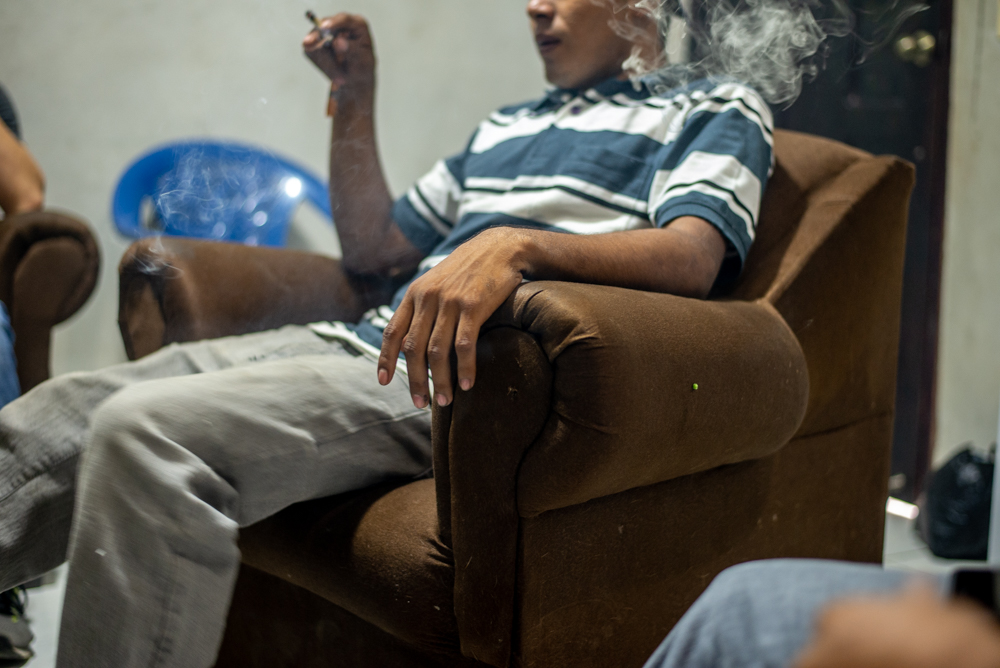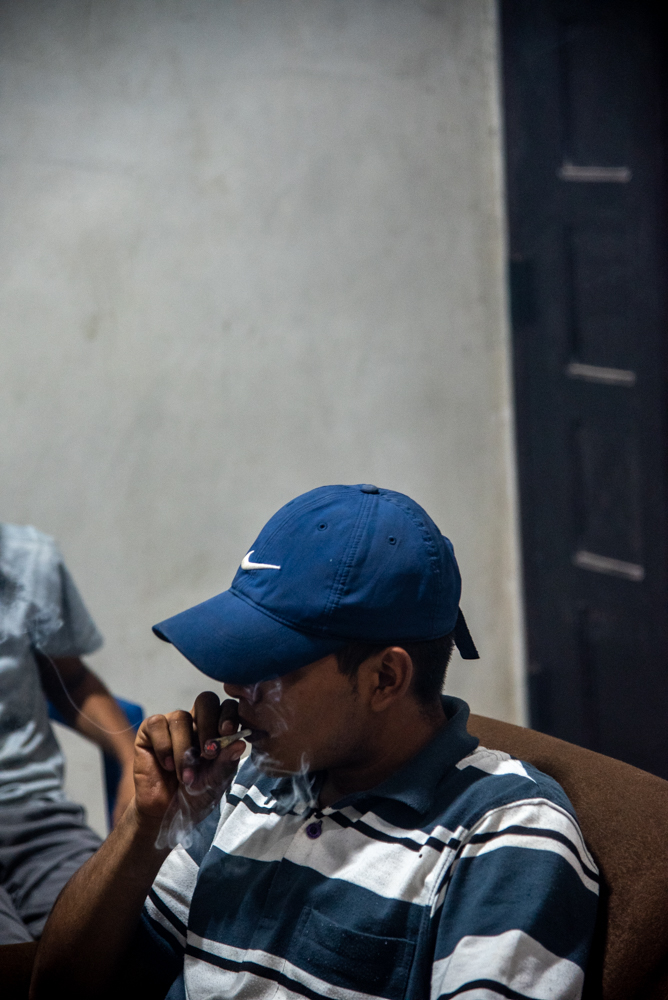
This report original appeared in Vice News
SAN PEDRO SULA, HONDURAS – In a drug house in the heart of a slum controlled by the MS-13 street gang in the city of San Pedro Sula, Honduras, a gang member saunters in and dumps his product on the table.
On one side is cocaine, each portion twisted into wraps of parchment paper. On the other lie several dozen impeccable plastic baggies of the gang’s newest cash-cow: a powerful strain of chemically-altered marijuana known as Krispy, or Tiburón (which means “shark” in English).
It’s unclear what chemicals or substances have made the new drug so addictive, but the gang has been making a killing off it.
“We’ve sold a lot,” said “El Pedro”, a gang member who met with VICE World News in the Chamelecón neighborhood. His gaze was misty after smoking the drug all afternoon. “There’s a lot of addicts to Tiburón now. It’s almost as addictive as cocaine… Everyone from the youngest kids to really old people consume it now.”

MS-13, a gang whose violent crimes United States President Donald Trump has frequently referenced to justify harsh immigration policies, was born four decades ago on the streets of California, formed by refugees from the El Salvadoran civil war. In the early 1990s, the gang metastasized after U.S. deportation policies dumped them en masse into Central America, where the burgeoning drug trade and easy availability of military grade weapons created a fertile environment for criminal groups.
They’ve since become major hawkers of drugs on the streets of Honduras, itself one of the main transit hubs for illegal drugs headed to the United States. MS-13 began selling Krispy (Tiburón is one kind of Krispy, and the strongest), which goes for twice, sometimes three times the price of normal weed, just before the COVID-19 lockdown began in Honduras, according to observers interviewed by VICE World News.
“Every day, we make around 8,000 to 10,000 lempiras ($328 – 409),” another gang member called “El Ardilla” (which means Squirrel in English) told VICE World News. He picked up a packet of Tiburón between his fingers. “Now this costs 100 lempiras. Before, it only cost 30 or so. The demand was less. Now it’s 100, and we’re making up to 10,000 a day. It’s our best-selling drug,” he said.

As they talk, they play FIFA on a Playstation and get high off joints of Tiburón, smoking with measured inhalations, out through their mouths and back in through their noses.
Street gangs such as MS-13 and Barrio 18 started taking control of drug street sales in Honduras in 2015, according to media reports. That year, there was a spike in violence as the gangs replaced independent distributors – street dealers without direct connections to the gangs – and then fought one another for larger slices of territory. MS-13 now claims to exert a near-total monopoly over Tiburón, which they say their main rivals, Barrio 18, have been unable to break into.
“They don’t have the same supplier as us,” El Ardilla told us. “They’ve stayed with the same old marijuana. With the 30 lempira stuff.”
Salvadoran anthropologist Juán Martínez, an expert on the gangs, says the exploding sales of Tiburón by MS-13 have to be understood in the context of the gang’s changing business model. It “has a lot to do with the new commercial and economic possibilities for the gang… the MS is trying to move away from just using extortion as a means of profit, and is moving towards having businesses of their own out in the open, legal and illegal. Like the gangs owning businesses, like selling drugs, or doing large-scale money laundering.”

The global drug trade has also been undergoing a tectonic shift as traffickers rely less on plant-based drugs and more on synthetic or synthetically-altered ones, such as methamphetamine. The latter doesn’t have to be transported long distances across borders, and can be made cheaply to create a more addictive effect than the natural plants previously available.
But Tiburón is generating more violence between gangs already known for their brutal tactics that prompt tens of thousands to seek asylum in the United States every year. To gain territory for more “pozos” or drug houses that now sell Tiburón, MS-13 has been on the offensive.

On the front line of Chamelecón’s rural fringes, where MS-13 had been fighting its way into Barrio 18 turf, gunmen kept watch over a corridor of territory that had been abandoned by most residents due to frequent gun battles.
Two gang members with AR-15s lounged in the abandoned hulk of an unfinished house. Blankets of vines snaked through the windows, plastic trash scattered the ground, and bullet holes marked the wall. The men, fondling their weapons while peeking over the windowsill at the occasional enemy gang member or patrolling military police truck, were smoking joints of Tiburón.
The MS has been engaged in an ongoing territorial offensive into Barrio 18 territory – an act of vengeance for what the gunmen described as the “savagery” of the Barrio 18. At the same time, they dropped constant mention of the need for more territory to sell Tiburón.
“They view Krispy and Tiburón as their ticket into serious drug trafficking alongside the Mexicans,” said Douglas Farah, a researcher on gangs with 30 years experience in Central America.
Although most interviewed by VICE World News said that Tiburón is more addictive than cocaine, no one seemed capable or willing to say what chemical it was that was being used to enhance the new weed.

Altered marijuana is so rare in comparison to all-synthetic or all-natural brands that some suspect Tiburón may be “a cheap domestic strain that’s been fortified by potentially dangerous chemicals to enhance the low potency,” said Sanho Tree, a fellow at the Institute for Policy Studies who directs the drug policy project.
Past reports show synthetic weeds have been contaminated with rat poison, or myriad chemicals imported from Asia.
“Ten or fifteen years ago, the first generation of those synthetics weren’t too harmful,” said Tree. “But they’ve banned many of the chemicals that were used. So now they’ve gotten more and more creative with drugs to give the same effects, and we now have no idea what the public health effects could be. It’s pretty bad… You see people totally zombied out on this stuff.”
Members of MS-13 are unwilling to talk about what Tiburón is made of, said Farah. Users of the drug jokingly told him and VICE World News that it’s altered with gasoline. But the limited evidence Farah has suggests to him that the marijuana may have cocaine baked into it, which, if true, he said could explain its dangerous addictiveness.
“If you’re a Krispy user, you have a lot more of the effects of harder drugs,” he said. “What’s really disturbing is their willingness to sell it to anybody. You’re getting younger and younger people, kids even, involved in the consumption of something that’s even more addictive than marijuana. If the health effects are not widely visible yet, they will be soon.”
“[Sales] doubled,” thanks to the pandemic, said El Ardilla, as he took a long suck on a joint. “Because the whole world was stuck in their house. They couldn’t work, and at the same time, the quality of the weed has gotten better and better.”
Tiburón’s growth shows no signs of abating, and users and observers can only wait to discover the negative health effects as use increases.
